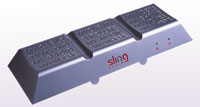Author: Gerry Blackwell
Review Date: 5/10/2006

The SlingBox, a $250 network device from Sling Media that lets you access your pay TV service or PVR content from any Windows computer with a high-speed network connection — including a Windows Mobile Smartphone or PDA on a cellular network — is sure to be the first of a new category of consumer network products.
In fact, the SlingBox is arguably the second. Sony‘s LocationFree TV, a portable LCD TV, offers some of the same functionality for $1,500. The Sling Media product lets you use the portable LCD you already own: your laptop or PDA. On the other hand, it requires you to have an existing wired or wireless Ethernet network. The LocationFree TV creates its own wireless network.
We were very impressed with the SlingBox. It’s a cool idea and well executed. However, it’s not perfect. It works great around the house, but when you take it away from home and connect via the public Internet, you run into all the congestion and reduced bandwidth problems familiar to anyone accessing streaming video on the Internet. And if you use a cable modem Internet service, those problems may be worse because the video is streaming over a connection shared with everybody else in your neighborhood.
Still, if you like the idea of being able to take your TV wherever you go, the SlingBox is worth considering.
How It Works
First you connect cables from secondary audio and video outputs on your pay TV receiver to the book-size SlingBox. You can use composite RCA, S-video or coaxial cables. Sling Media provides all three. Then you hook the SlingBox up to your network. If the router is in the same room, you can run Cat-5 Ethernet cable. If it’s not, and your network is wireless, you can use a wireless bridge to connect the SlingBox. Or Sling Media will sell you a pair of powerline Ethernet adapters for $100.
The final piece of the hardware set-up is installing the provided infrared (IR) extender cable. One end plugs into the SlingBox. The other end has two IR transmitters. You use the self-sticking material provided to affix them to your TV set-top box so the transmitters point at the box’s IR receiver. This is crucial because it gives you control of your TV receiver over the network from any device connected to the SlingBox, just as if you were using the physical remote.
Next, install the SlingPlayer software on your networked Windows PCs. You can install it on as many as you want. The software turns computers into TVs, letting you view video streamed from the SlingBox in a window on the PC monitor, or full-screen.
When you set up the software, you tell the SlingBox which service you use. It has built-in support for most North American pay TV and PVR services, including TiVo and Bell Expressvu a Canadian satellite service we used in testing. The software includes an onscreen remote control that looks and functions exactly like the real remote for your service. Mouse-clicking the buttons sends the same commands to your TV receiver – display the onscreen guide, change channels, adjust volume, etc. You can browse the onscreen guide and set up recordings from anywhere.
Sling Media is also currently offering a free beta version of its Windows Mobile client. The mobile software doesn’t give you a look-alike onscreen remote control – there just isn’t room on the little screen – but it does give you the same functional control. By tapping an onscreen button, you can switch from portrait to landscape view, which lets you watch full-screen.
Ready, Set, Problem Solve
Setting up the SlingBox was no cake walk. We can’t attribute the problems we experienced directly to the Sling Media product, but they’re problems other people might encounter too.
Most people don’t have their network router and pay TV receiver in the same room, including us. And we weren’t going to run Ethernet cable all over the house. One option is powerline Ethernet adapters. You plug in one in the room where the router is and run an Ethernet cable from it to the router. You plug in the other in the room where the SlingBox is located and use Ethernet cable again to link them. The end-to-end connection is made over the household wiring.
W already knew that powerline Ethernet adapters probably wouldn’t work. The house we tested in is over 50 years old with old-fashioned wiring. The room where we located the router is on a different circuit from the room where the set-top box is located, and the powerline adapters couldn’t make an end-to-end connection. We tested Sling Media’s adapters and similar products from Actiontec.
We have a wireless network, but using a wireless bridge to connect the SlingBox turned out to be more problematic than we expected: not all bridges play nicely with all routers. We used a Buffalo Technology router — the WZR-RS-G54 125 High-Speed Mode (HSM) Wireless Secure Remote Gateway. We tried connecting the SlingBox to it using a Linksys Ethernet G Wireless Bridge, one recommended by Sling Media. No soap.
We spent the better part of a day trying everything we could think of and spending more than two hours on tech support calls to the three companies involved. They couldn’t help. When we finally thought to switch to a different router, a D-Link AirPlus Xtreme G unit, the problems magically disappeared.
The network is 54-megabits-per-second (Mbps) 802.11g, but even an 11-Mbps 802.11b network would provide enough bandwidth since the SlingBox rarely uses more than 1.5 Mbps for streaming video. The router was in a room almost directly above the SlingBox, so the signal over the wireless bridge connection was quite strong.
Sling Media provides a Wizard that walks you step-by-step through installing the software, and even though it’s a bit complicated, it was a breeze compared to solving the network problems. You have to set up the dynamic DNS service – provided by Sling Media – that lets you access the SlingBox remotely over the Internet.
The Wizard masked most of the complexity, and we were up and running, watching TV on the first PC we installed in less than 20 minutes. We installed it on two other PCs on the network, including a wireless laptop. Installing on a Dell Axiom X51V Pocket PC was also relatively simple, though we did have to upgrade the Microsoft ActiveSync software on the PC before we could use the Sling Media automatic installer. The automatic installer took SlingBox settings from the PC to configure the PDA software.
How Good is It?
Around the house, when we were viewing TV at normal size in a window – which on our laptop, with display set to 1024×768 pixels, is about two-thirds of the screen – the image looked very good, near-broadcast quality. Motion was smooth, the image was sharp enough, though not as sharp as a good TV. And sound was very good.
When we enlarged the image to full screen, we could begin to see some pixilation – jaggies around the edges of moving objects. It was still watchable, but less so when viewing sports action, for example. The SlingPlayer also worked remarkably well on the Dell Axim, though, again, we could see some pixilation in fast-moving objects.
Watching while away from home was a whole different ball game. We tested the technology by taking the laptop to a local bar with Wi-Fi service. This was on a Sunday afternoon, so contention for the wireless bandwidth was practically nil. The test should have stacked the deck in the SlingBox’s favor. The Wi-Fi connection was faster than any cellular connection we might have tried and the connection had to traverse fewer router hops than if we’d been in South Africa, for example.
The results were a little disappointing. Video was jerky, and it frequently broke up or froze. The audio was better, but it occasionally broke up too. It was unwatchable for anything other than basic talking-head TV.
Bottom Line
Despite the disappointment in remote performance, it’s hard not to like the SlingBox. It’s just out-and-out cool and works very well around the house. It’s conceivable you’ll experience better video quality than we did when connecting remotely, but don’t count on it. That said, just being able to watch your local newscast on a PDA screen while traveling might be worth the price of admission. And you can also use it to set up recordings you forgot to program before leaving home.
Gerry Blackwell is regular contributor to PracticallyNetworked.com.



